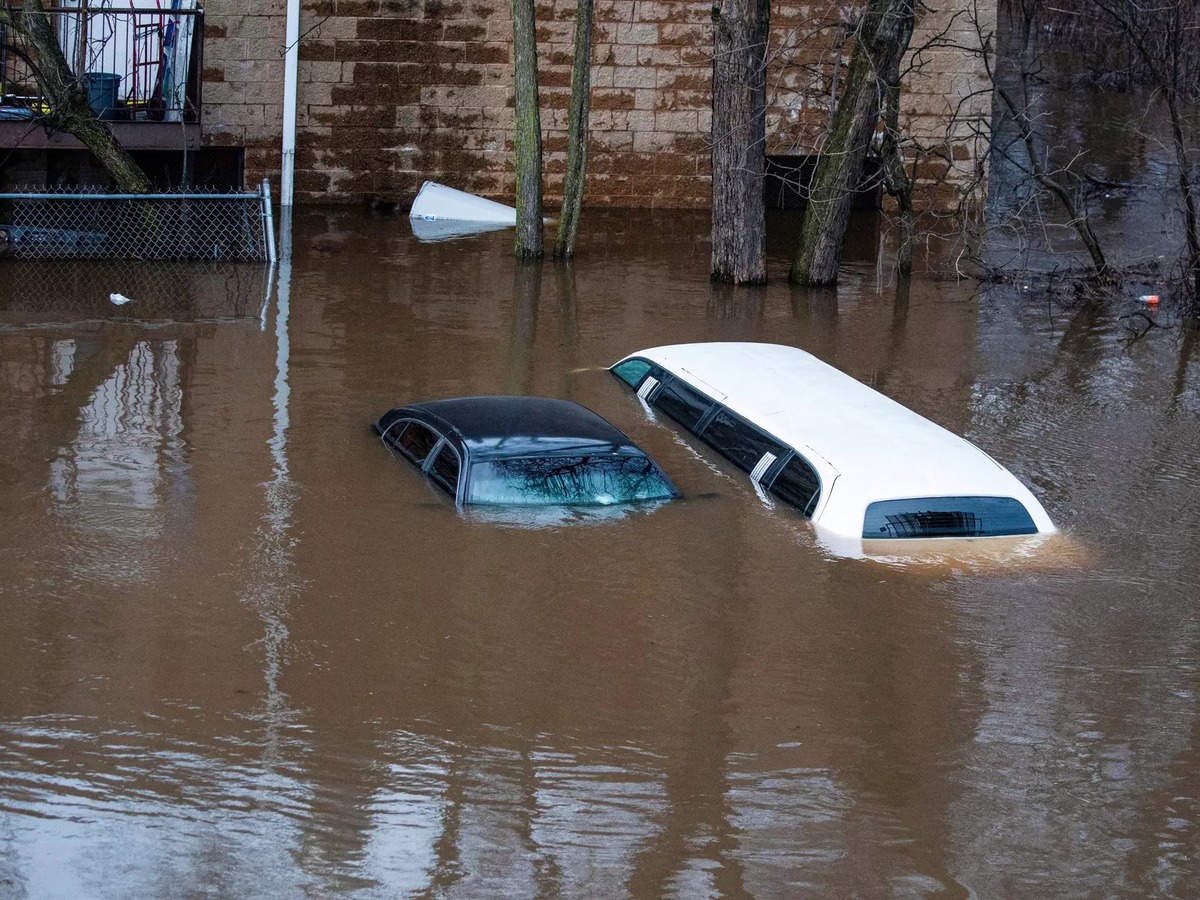Home>Weather and Climate>Heatwave To Peak At 36°C With Flash Floods And Thunder Expected


Weather and Climate
Heatwave To Peak At 36°C With Flash Floods And Thunder Expected
Published: March 7, 2024
Stay prepared for extreme weather as the heatwave peaks at 36°C, bringing flash floods and thunderstorms. Get the latest updates on weather and climate. Stay safe!
(Many of the links in this article redirect to a specific reviewed product. Your purchase of these products through affiliate links helps to generate commission for Temperatures.com, at no extra cost. Learn more)
Table of Contents
Understanding the Heatwave
A heatwave is a prolonged period of excessively hot weather, which may be accompanied by high humidity. It is a natural phenomenon that occurs when a high-pressure system traps warm air in a particular area, causing temperatures to soar. Heatwaves can have a significant impact on both the environment and human health.
During a heatwave, the air temperature rises significantly above the average for a specific region. This can lead to a range of adverse effects, including heat exhaustion, heatstroke, and dehydration. Additionally, vulnerable populations such as the elderly, young children, and individuals with pre-existing health conditions are at a higher risk of heat-related illnesses during these extreme weather events.
The combination of high temperatures and humidity during a heatwave can make it challenging for the body to cool itself through the natural process of sweating. As a result, prolonged exposure to these conditions can lead to heat-related illnesses, which can be life-threatening if not managed promptly.
In urban areas, the phenomenon of urban heat islands can exacerbate the effects of a heatwave. Urban heat islands occur when concrete, asphalt, and other heat-absorbing materials in cities retain heat, causing temperatures to be higher than in surrounding rural areas. This can further intensify the impact of a heatwave, making it crucial for city dwellers to take extra precautions during these periods of extreme heat.
It's important to note that heatwaves can also have far-reaching consequences for the environment. Prolonged periods of high temperatures can lead to drought conditions, which can have a detrimental impact on agriculture, water resources, and wildlife. Additionally, heatwaves can contribute to the formation of ground-level ozone and air pollution, further impacting the environment and human health.
Understanding the dynamics of a heatwave is essential for taking proactive measures to mitigate its impact. By staying informed about weather forecasts and heeding heatwave warnings, individuals and communities can take steps to stay safe and minimize the adverse effects of extreme heat. This may include staying hydrated, seeking out air-conditioned spaces, and checking on vulnerable individuals to ensure their well-being during these challenging weather conditions.
Read more: Cleveland Ohio Peaks at Record Heat Wave
Impact of 36°C Peak Temperature
A peak temperature of 36°C can have far-reaching implications for both human health and the environment. As the mercury rises to this level, the risk of heat-related illnesses escalates, particularly for vulnerable populations such as the elderly, young children, and individuals with pre-existing health conditions. Prolonged exposure to such high temperatures can lead to heat exhaustion, heatstroke, and dehydration, posing a significant threat to public health.
In addition to the direct impact on human well-being, a 36°C peak temperature can also exert stress on critical infrastructure and essential services. The demand for electricity surges as air conditioning systems work overtime to combat the sweltering heat, potentially leading to power outages and placing additional strain on the power grid. Furthermore, transportation networks, particularly railways, may experience disruptions due to the expansion of metal tracks under extreme heat, necessitating precautionary measures to ensure the safety and efficiency of travel.
The environmental repercussions of a 36°C peak temperature are equally noteworthy. Ecosystems can suffer as vegetation becomes susceptible to heat stress, leading to reduced agricultural yields and potential damage to natural habitats. Water resources may also be strained, as higher temperatures contribute to increased evaporation rates, potentially exacerbating drought conditions and impacting water availability for both human consumption and agricultural irrigation.
Moreover, the urban heat island effect can intensify the impact of a 36°C peak temperature in densely populated areas. The built environment, characterized by concrete and asphalt, absorbs and retains heat, causing urban areas to experience even higher temperatures than their rural counterparts. This phenomenon not only amplifies the risk of heat-related illnesses but also contributes to elevated energy consumption for cooling, further straining resources and exacerbating the urban heat island effect.
In light of these potential consequences, it is imperative for individuals, communities, and authorities to take proactive measures to mitigate the impact of a 36°C peak temperature. This may involve implementing heatwave response plans, providing access to cooling centers for those in need, and raising awareness about the importance of staying hydrated and seeking relief from the heat. Additionally, urban planning strategies that incorporate green spaces and reflective materials can help mitigate the urban heat island effect, contributing to a more resilient and sustainable urban environment.
By understanding the multifaceted impact of a 36°C peak temperature, stakeholders can work collaboratively to address the challenges posed by extreme heat, safeguard public health, and promote the resilience of communities and ecosystems in the face of escalating temperatures.
Preparing for Flash Floods
Flash floods are sudden and powerful inundations of water that can occur with little to no warning, posing a significant threat to lives and property. These rapid-onset events are often triggered by intense rainfall, dam breaches, or sudden snowmelt, leading to the swift accumulation of water in low-lying areas. In light of the destructive potential of flash floods, it is crucial for individuals and communities to take proactive measures to prepare for and respond to these hazardous events.
Understanding the Risk
The first step in preparing for flash floods is to understand the risk within a specific geographical area. This involves identifying flood-prone zones, assessing local drainage patterns, and staying informed about the potential triggers for flash flooding, such as heavy rainfall or rapid snowmelt. By understanding the specific vulnerabilities and risk factors associated with flash floods, individuals and communities can better prepare for and mitigate the impact of these sudden inundations.
Developing an Emergency Plan
Creating a comprehensive emergency plan is essential for effectively responding to flash floods. This plan should include evacuation routes, designated meeting points, and communication protocols to ensure that all family members or community members are aware of the necessary steps to take in the event of a flash flood. Additionally, it is important to establish emergency supply kits containing essential items such as non-perishable food, water, first-aid supplies, and important documents to sustain individuals and families during and after a flood event.
Read more: London Braces for Sweltering 29C Heat Wave
Securing Property and Infrastructure
Taking proactive measures to secure property and infrastructure can help minimize the impact of flash floods. This may involve elevating electrical systems and appliances, installing backflow valves to prevent sewage backup, and using sandbags to divert water away from buildings. Additionally, clearing gutters and drainage systems of debris can help facilitate the efficient flow of water, reducing the risk of localized flooding around homes and businesses.
Staying Informed
Remaining informed about weather forecasts and flood warnings is critical for staying ahead of potential flash flood events. Utilizing weather alert systems, monitoring local news updates, and staying connected to community emergency response channels can provide valuable information and early warnings, allowing individuals to take timely action to protect themselves and their property.
Community Preparedness
Community-wide preparedness efforts, such as conducting drills and exercises to simulate flash flood scenarios, can enhance overall resilience and coordination in the face of these sudden-onset events. Collaborating with local authorities, emergency responders, and community organizations to develop and practice flood response plans can help ensure a cohesive and effective response to flash flood emergencies.
By proactively preparing for flash floods through risk assessment, emergency planning, property protection, staying informed, and fostering community preparedness, individuals and communities can enhance their resilience and ability to mitigate the impact of these rapid-onset inundations, ultimately safeguarding lives and property in the face of flash flood events.
Staying Safe During Thunderstorms
Thunderstorms are powerful meteorological events characterized by lightning, thunder, heavy rainfall, and, in some cases, hail and strong winds. These intense atmospheric disturbances can pose significant risks to individuals and communities, making it essential to understand and implement safety measures to mitigate the potential hazards associated with thunderstorms.
Read more: August Weather In Iceland: What To Expect
Seeking Shelter
When thunderstorms are forecasted or imminent, seeking appropriate shelter is paramount. Indoors, a sturdy building or a fully enclosed vehicle provides the best protection from lightning strikes. It is crucial to avoid seeking shelter in open structures, picnic shelters, or isolated sheds, as these locations do not offer adequate protection from lightning and other storm-related hazards.
Avoiding Electrical Appliances and Plumbing
During a thunderstorm, it is advisable to refrain from using electrical appliances, landline telephones, and plumbing fixtures. Lightning can travel through electrical and plumbing systems, posing a risk of injury to individuals in contact with these conduits. Unplugging electronic devices and avoiding the use of water-related fixtures such as sinks and showers can help reduce the risk of electrical shocks during a thunderstorm.
Staying Indoors
Remaining indoors during a thunderstorm is crucial for personal safety. While inside, it is advisable to stay away from windows, doors, and concrete walls, as these structures can conduct lightning. Additionally, it is important to avoid contact with conducting surfaces such as metal pipes, as they can transmit electrical currents in the event of a lightning strike.
Postponing Outdoor Activities
Engaging in outdoor activities during a thunderstorm significantly increases the risk of lightning-related injuries. Therefore, it is essential to postpone outdoor activities such as sports events, picnics, and recreational pursuits until the thunderstorm has passed and the environment is deemed safe by weather authorities.
Read more: Maui Weather in October: What to Expect
Monitoring Weather Updates
Staying informed about weather updates and thunderstorm warnings is critical for making informed decisions regarding personal safety. Utilizing weather alert systems, monitoring local news broadcasts, and staying connected to official weather channels can provide valuable information and early warnings, enabling individuals to take appropriate action to protect themselves and their families during a thunderstorm.
Providing Support to Vulnerable Individuals
During thunderstorms, it is important to provide support to vulnerable individuals, such as the elderly, young children, and individuals with disabilities, who may require assistance in seeking shelter and adhering to safety guidelines. Ensuring that vulnerable individuals are well-informed and supported during thunderstorm events is essential for their well-being and safety.
By adhering to these safety measures and guidelines, individuals and communities can effectively mitigate the risks associated with thunderstorms, safeguarding lives and promoting resilience in the face of these powerful meteorological events.












